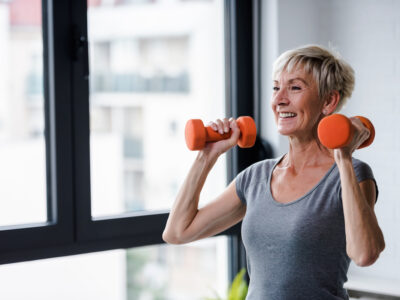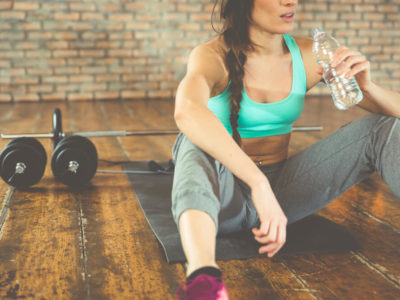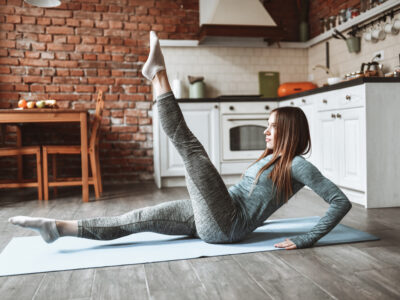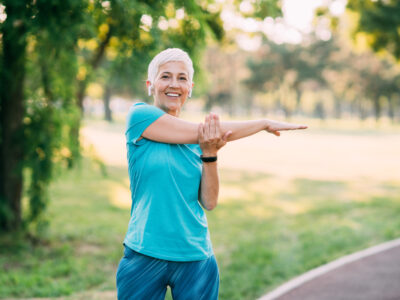Table of Contents[Hide][Show]
Does the thought of working out fill you with dread?
No one wants to be aching and exhausted for days. And luckily, you don’t have to be!
Low-impact exercises deliver impressive results for your mind and body, without the harsh movements and sore muscles.
And with easily modifiable options, they’re perfect for everyone and anyone, from fitness newbies to health enthusiasts.
Ready to try a new fitness routine? Let’s step—not jump—into the world of low-impact exercise.
What Is Low-Impact Exercise?
Low-impact exercises, as suggested by the name, are exercises or activities that you can do without jumping, slamming, or other jarring motions. Instead, low-impact exercise focuses on gentler, more fluid motions that avoid undue stress or pressure on your joints and muscles.
Some trainers or experts even take it a step further by saying that for an exercise to be low-impact, you should always keep at least one foot on the floor. In other words, no movements that require you to jump or leap and then land back on the ground—avoiding that impact force on your joints.
An easy way to picture low-impact versus high-impact exercise is to imagine walking versus running. These two may seem like similar exercises, but there are huge differences when it comes to the actual movements in each and the stress they bring to your joints and muscles.
One exception to the “one foot on the ground” guideline would be water-based activities such as swimming or water aerobics. Although you might have both feet off the ground, the water will sustain some of your weight and take pressure off your body.
Related
How Lipopolysaccharide Contributes To Joint Pain
When suffering from joint pain, not many people talk about lipopolysaccharide. That’s because not many are aware of what it is and how it contributes to joint pain, so let’s take a closer look now. Here are 10 ways lipopolysaccharides can contribute to join pain.
Low-Impact Vs. Low-Intensity
Low-impact exercises can be easily modified to suit almost any physical ability or preference, making them the go-to fitness choice for many.
But don’t confuse low-impact with low-intensity!
Just because an exercise is considered to be low-impact, doesn’t mean that it’s not intense. And if you’ve ever seen sweaty, exhausted gym-goers exiting a spin studio or yoga class, you’ll have seen this first-hand.
Another thing to keep in mind is that most of these exercises are highly customizable.
Take walking, for instance, a common low-impact exercise. You can start off slowly, then add speed, incline, and time to raise the intensity. Or you can move to a different low-impact machine that feels more challenging, such as the elliptical.
Is Low-Impact Exercise For You?
Yes! Low-impact exercise, with its easy modifications and adaptability, can be a great option for almost anyone who’s looking to get healthier.
Some people, however, would especially benefit from low-impact exercise.
Consider low-impact exercises if you are:
- New to exercise. It’s an effective way to introduce your body to exercise. You can adapt intensity, duration, and length of time as your body gets used to physical movement.
- Haven’t exercised in a while. Low-impact exercise can bridge the gap from your previous fitness level to your current capacity, helping you work your way back up.
- Are recovering from an injury. These exercises can help you stay fit and keep you moving. And, you can modify low-impact exercises to avoid placing undue stress or pressure on injuries.
- Are significantly overweight. Low-impact exercises can form the foundation of your workouts, easing you into the world of fitness. As you lose weight and become stronger, you can intensify your workouts.
- Are an older adult. Low-impact exercises can keep you strong, healthy, and independent as you age, while allowing for modifications that are gentler on your joints and muscles.
While these groups may be particularly well-suited to low-impact exercises, the truth is that almost anyone can enjoy this type of gentler, less jarring movement.
And, you don’t have to dedicate your fitness routine solely to low-impact exercises. If your health allows for—and you prefer—high-impact exercises, mix it up by adding low-impact options to your current routine. This gives you more options whether you’re traveling, are experiencing muscle soreness, or simply when you want to move your body on a rest day.
But are low-impact exercises effective? What are their benefits? Let’s take a look at how low-impact exercise can improve your health.
Related
The Best Exercises For Seniors
Just because you’re getting older doesn’t mean you can’t still be fit, active, and glowing with health and energy. Let’s take a look at some of the best exercises for seniors and how they can benefit your mind and body.
.
The Benefits of Low-Impact Exercise
For years, some people in the fitness community lived by the “no pain, no gain” motto.
Thankfully, studies have shown that this approach to exercise is outdated and that low-impact exercises offer a wealth of benefits.
Some of the benefits of low-impact exercise include improvements in the following areas.
- Balance
- Endurance
- Flexibility
- Gait velocity
- Lower body strength
- Pain tolerance
- Peak oxygen consumption
- Range of motion
Due to improved balance and lower-body strength, low-impact exercise has also been shown to reduce the risk of falling, particularly among older adults.
Low-impact exercise can also improve your mental health.
- Improved cognitive function
- Reduced depression
And because there are low-impact choices for both cardio workouts and strength training, they can help you lose weight and build muscle.
Some low-impact exercises can also be good for stress relief, especially those that emphasize a mind-body connection, such as yoga, tai chi, or walking in nature.
Are you ready to start a low-impact workout? Let’s look at just a few of the many options available to you.
Low-Impact Cardio Exercises
Also known as low-impact aerobic exercises, these are the exercises that boost your cardiovascular health. In general, they can be sustained for longer periods of time, such as walking for 45 minutes versus sprinting for 10 minutes.
Here are some low-impact cardio exercises you may enjoy.
- Cycling
- Dancing (some styles)
- Elliptical
- Rowing
- Swimming
- Walking
Remember, you can make these more challenging! Add inclines, speed, and/or duration to make any of these exercises more challenging. Or add weights, such as ankle weights or a weighted vest.
Low-Impact Resistance Exercises
Resistance exercises, also known as strength training exercises, are very easy to adapt into a low-impact exercise.
In fact, by their very nature, most of these are low-impact; your feet don’t need to leave the ground in order for you to do bicep curls, squats, or crunches.
Here are some of the top low-impact resistance exercises.
- Barre workouts
- Bodyweight exercises, such as squats or pull-ups
- Resistance band exercises, such as pull-aparts or band rows
- Resistance machine exercises, such as the leg press machine or the abductor/adductor machine
- Tai chi
- TRX
Aquatic workouts can also be transformed into strength workouts, with the addition of pool weights. These are specialty weights designed to create an added challenge in the water.
You can find aquatic weights such as water dumbbells, hand and ankle weights, resistance gloves, buoyancy vests, and aqua belts online and in specialty fitness stores.
Related
Fitness Boost: The Best Strengthening Exercises
Check out our top strengthening exercises for the lower body, upper body, core, and back, plus 5 tips for making the most of your workout.
Other Low-Impact Exercises
Alongside traditional cardio and strength training exercises, you have other options for low-impact exercises.
Yoga and Pilates
Both of these exercise formats are mostly if not fully low-impact, and will need few modifications.
Both yoga and Pilates are focused more on strength training.
- Holding yoga poses such as Warrior engages and strengthens your muscles, which is enhanced through repetition.
- Pilates exercises such as The Hundred focus on core strength. Other exercises such as leg lifts strengthen and tone other muscles.
However, yoga and Pilates can also be good for a cardio workout.
- “Flow” yoga classes such as Vinyasa yoga incorporate continuous movements that can elevate your heart rate. Hot yoga or a longer yoga class can do the same.
- Advanced Pilates classes such as mat Pilates or faster-paced classes offer a cardio component, as do fusion classes such as HIIT Pilates or Cardio-Kick Pilates.
Low-Impact HIIT Exercises
Even a HIIT workout can be low-impact if it’s done correctly!
HIIT stands for High-Intensity Interval Training.” While many people make it high-impact with moves such as squat jumps or jumping jacks, you absolutely can make your HIIT workout just as challenging while keeping it low-impact.
The key to a successful low-impact HIIT workout is to find exercises that challenge your body—and your fitness level—without the jarring, slamming motions associated with a high-impact workout.
A HIIT workout consists of alternating periods of high-intensity exercises with periods of rest or lower-intensity exercises. For example, you can do a higher-intensity move for 30–45 seconds, then take 15 seconds to rest/recover.
As long as you choose low-impact exercises, or modify traditional HIIT exercises to make them low-impact.
Here are some low-impact HIIT exercises you can use in your workout.
- Modified burpees: Step your feet out one at a time
- High knees: Bring your knees to your chest as you march in place
- Butt kicks: Bring your heels to your glutes as you march in place
- Squats, with weights, resistance bands, or variations for added difficulty
- Planks and plank variations
- Push-ups, on your knees or against the wall if needed
- Standing crunches
- Alternating lunges
In between sets of these high-intensity moves, you can take a short rest period or perform a lower-intensity move such as marching in place or step-touches.
Related
The Perfect Post Workout Routine
Workouts are hard enough, but did you know your post workout routine could make all the difference? Here is the perfect one for you.
Getting The Most Out of a Low-Impact Workout
Make sure you maximize your fitness routine!
Follow these strategies for a better low-impact workout, every time.
Start Slowly
If it’s been a while since you worked out or you’re recovering from an illness or injury, start off slowly. Ease your way back into fitness to avoid injuries that could derail your progress.
Stay Hydrated
Depending on your choice of exercises, you might not get as sweaty during a low-impact workout as you would if you were running or doing jumping jacks. But you still need to stay hydrated!
Drink plenty of water before, after, and during your workout to keep your muscles from cramping, regulate your body temperature, elevate your performance, and avoid dehydration.
Get Good Sleep
Sleep is vital when you’re exercising. Try to get between 7–8 hours per night, so that you have the energy to move efficiently and perform at your optimal capacity when you’re working out.
Add Variety
Instead of focusing on just one form of exercise, keep it fun by switching things up. Try a yoga class one day, go for a walk the next, and try some bodyweight exercises on the third day.
Doing different types of exercises allows you to work different muscle groups for better overall results. And, it combines the benefits of both cardio and resistance workouts, so you’ll get their combined benefits—stronger muscles, improved cardiovascular function, increased endurance, stamina, and power, and more.
Plus, you’ll avoid overworking specific muscles, which will help you avoid stress injuries and muscle soreness.
Take a Probiotic
Probiotics are an amazing ally along your fitness journey.
We recommend our favorite probiotic from Just Thrive, a high-quality spore-based probiotic supplement that supports your fitness lifestyle in several crucial ways.
- Improves sleep quality and quantity, so you’re well-rested and ready to move your body
- Encourages a healthy body mass, maximizing your workout results
- Promotes optimal immune function, keeping you healthy so you can work out
And with four clinically-proven, DNA-verified strains of beneficial bacteria, it supports a healthy and balanced gut microbiome, benefitting your overall well-being.
Final Thoughts
Ready to put on your favorite workout gear and head out for some exercise?
Low-impact exercises are an excellent option for getting fit, strong, and healthy. They can give you all the benefits of a workout, with easy-to-modify options that avoid stressful impacts on your joints and muscles.
Start with some of the exercises we highlighted for you, mix them up, and add new ones in when you’re ready.
And most importantly, enjoy being the healthiest, happiest version of you!
You May Also Like…








